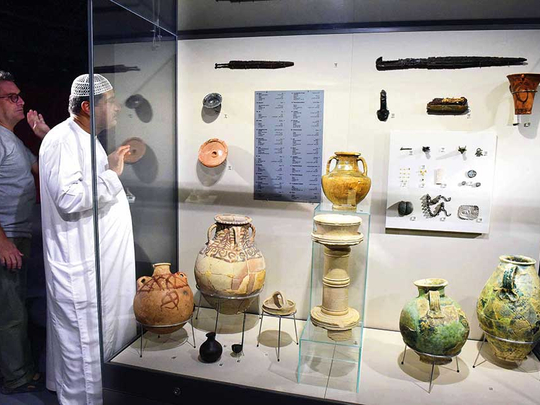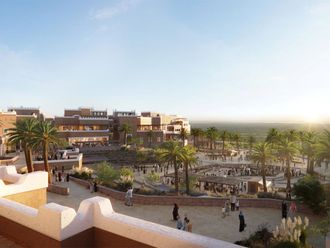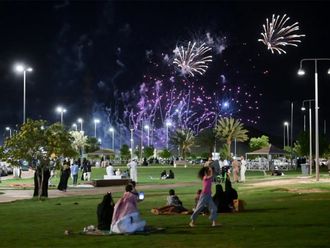
Sharjah: Less than an hour’s drive from Sharjah city, a desert centre that hosts rare wildlife boasts 135,000 years of human history — and stunning mountain views.
After driving down Sharjah’s Maliha Road, you pass through a thin sliver of a mountain pass. Then, you’ll drive through the main street of Maliha town, a sleepy place with grassy roundabouts and tiny shops to serve some 2,000 residents.
Many of them are Bedouin camel farmers, who live in tight-knit, white-walled communities.
A view of villages in Maliha area. Maliha town and surroundings have some 2,000 residents. Many of them are Bedouin camel farmers.
Right next to the town, off a dirt track, is the Maliha Archaeological Centre. (In case you are confused: the right way to spell is Mleiha — which means ‘salt’ in old Arabic, or a feminine term for ‘beauty,’ as Bedouins say — is currently under debate.)
When you get there, make sure to drive slow. Herds of camels, and desert donkeys, often roam around the area. According to the centre’s guides, the camels all belong to local farmers, and always return to their enclosures when the sun goes down.
When Gulf News paid a visit, we were shown around by Ajmal Hasan Mohammad, the centre’s education manager, who enthusiastically shares anecdotes on Maliha’s history and its sights.
Ajmal Hassan Mohammad explains the activities of Maliha Archaeological Centre and the history, geography and unique features of the desert area to visitors.
First, we start at the centre’s earliest human history. As far back as 135,000 years ago — give or take 10,000 years — people lived in the area. These Palaeolithic era people were believed to have originally come from what is now sub-Saharan Africa.
These settlers are believed to have been dark skinned, and as the unearthed remains show, short in height. Some of the remains also show skull damage, suggesting tribal fights, and, perhaps more intriguingly, signs of primitive medical operations.
One of the star exhibits of the Palaeolithic exhibition is a white flint axe head, as well as stone arrow heads and jewellery made from sea shells.
Rich history
The area’s geography helps explain why humans settled there.
Situated just 25 kilometres away from the Hajjar Mountains, the region would have once seen large amounts of water running off the mountains.
| Some of the star exhibits of the Palaeolithic exhibition at the Maliha Archaeological Centre is a white flint axe head and stone arrow heads. |
Archaeologists believe that there were several large lakes in the area up to 2,000 years ago.
The site was first excavated in 1973 by a team of Iraqi archaeologists on the request of the Sharjah ruler at the time. Currently, a German team is on the site — or was until the summer heat sent them home.
As well as water, the mountains may have also been a source of wealth to the area in later times. Some of the museum’s Bronze Age era exhibits show fragments of metal mined from the rock.
Other Bronze Age-era exhibits show ivory brooches, and a silver pendant of a griffin, a mythical creature with the legs of lion and wings of an eagle.
In 1300BC, during the Iron Age, the Arabian Peninsula began to dry out. This time likely caused some of the local population to die out.
At this time, archaeological evidence shows that the inhabitants had started to dig wells to capture the evermore scarce water.
A 200BC-era tombstone also hints at the region’s culture. The plaque, which is about the same size as a large paving slab, is written in two languages — early Arabic and Aramaic, a language spoken in some parts of the Roman Empire.
Greek-style pots and amphora jars from around the same time, known as the pre-Islamic era, from 400BC to 400AD, are also seen. Coins from this time show the faces of Roman emperors.
Back then, the area’s inhabitants worshipped several deities, including Shamash, a god of the Sun.
One ritual, known as Baliya, was particularly gruesome. In some of the tombs at the site, archaeologists unearthed the skeletons of several camels and horses that had been buried (presumably alive) along with their (and dead) wealthy owners.
Fun in the dunes
With the museum tour over, and the sun beginning to go down, it was now time to explore the outdoors.
The centre has eight off-road vehicles it uses to give visitors rides over the dunes. In keeping with Sharjah’s calmer reputation, the dune bashing is not supposed to be too wild. Not that that stops our driver from drifting and racing over the dunes.
Out in the desert, the red sands are juxtaposed with tall rock formations covered with fossils.
The 60-metre-tall rock formation studded with fossilised undersea creatures in Maliha. This is thought to date back from 65 to 75 million years ago when the area was a sea bed.
Most of the outdoor activities are focused around the mountains and rocks. The largest of these is Jebel Fayya, a 10km strip of mountains which are up to 350 metres in height.
The centre organises trekking through the range, where visitors can explore small caves once used by the area’s inhabitants for housing and storage.
Visitors can also go paragliding off the peaks, desert biking, and hammock camping in between the ghaf trees.
Plans are in place to offer horseback tours, camel rides, and desert survival training camp, and an eco-lodge offering overnight stays.
Apparently, some hardy American, British and French tourists have opted to brave the heat and do desert camping.
And while the weather is definitely very warm, due to Maliha’s location far away from the coast, humidity levels are far, far lower.
In the winter, temperatures drop to around 10 degree Celsius, staff say.
Out of the tour, our guide eagerly shows us all the sights.
One 60-metre-tall rock formation studded with fossilised undersea creatures is thought to date back from 65 to 75 million years ago.
At this time, the entire area was the bottom of the sea bed and gradually turned into a “kind of like an oceanic graveyard”, as our guide described it.
Rare animals
In the evenings, venomous desert snakes sometimes come out of the rocks. The elusive, cat-sized Arabian fox can sometimes be seen at nights by desert campers.
According to plans, plenty more rare wildlife may soon be seen in the area.
Shurooq, the Sharjah Investment and Development Authority which backs the centre, is currently planning a 450km Maliha National Desert Park to reintroduce indigenous wildlife, such as oryx and gazelles.
Visitors settle down for a barbecue dinner under the light from tiki-torches lit up by Maliha Archaeological Centre’s staff at the campsite near the rocks.
To mark the end of the tour, the centre laid out a sunset barbecue dinner at a campsite near the rocks.
There, the centre’s staff have lit up flaming tiki-torches, and are grilling meat on a barbecue.
Guests sit by a low table and are served hummus and salads alongside the meat, washed down with cold drinks from an ice-box. A coconut-flavoured Umm Ali, a traditional Gulf dessert, is served at the end.
Nearby, a telescope is set up for stunning views of the night sky. Because the camp site is so far away from the nearest city, there’s very little light pollution, and it offers clear views of the moon and stars.
Sitting at the camp, far away from crowds, noise and heat, proves to be a very relaxing experience — a fact that Ajmal Mohammad, the centre’s education manager, is keen to highlight.
“Maliha is a perfect destination for adventurers, family and individuals looking for a getaway from the hustle and bustle of the city,” he says, a couple of days after our visit.
Maliha’s main manager, Mahmoud Rashid Al Suwaidi, believes that the centre has a wide appeal.
“There is something to appeal to every taste here,” he says. “And that is what makes Maliha experience truly unique.”












